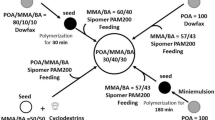Abstract
The conditions for the formation of a water-in-oil (w/o) Pickering emulsion resistant to coalescence and sedimentation with a droplet size of 2–12 μm, stabilized by talc microparticles were established: the oil phase is a 70% solution of CHS-EPOXX 530 resin in xylene, the aqueous phase is suspension of talc in water with a concentration of 6 g/100 mL (water + oil), volume ratio of phases 1 : 1, emulsification for 15 min at 293 K and a rotor speed of 7000 rpm. The formation of w/o emulsions is explained by the lyophobic-lyophilic heterogeneity of the talc microparticles surface, which has basal hydrophobic and lateral hydrophilic areas. High-quality films and coatings with a good degree of curing and mechanical strength were produced using the epoxy-polyamine adduct TELALIT 180 as a hardener. Their structure consists of a polymer framework, including microscopic capsules, which, can be filled with water (293 K) or air (353 K) depending on the curing temperature. Such microcapsules can be carriers of hydrophilic components, such as corrosion inhibitors or intumescent compounds, and can be used to fabricate protective paint and varnish coatings, including self-healing ones, in order to extend their service life. They can also serve as microreactors in the synthesis of metal oxide nanoparticles (MoO3, TiO2), which are effective catalysts for the oxidation of organic compounds.





Similar content being viewed by others
REFERENCES
Aveyard, R., Binks, B.P., and Clint, J.H., Adv. Colloid Interface Sci., 2003, vol. 100–102, pp. 503–546. https://doi.org/10.1016/S0001-8686(02)00069-6.
Binks, B.P., Colloid Interface Sci., 2002, vol. 7, pp. 21–41. https://doi.org/10.1016/S1359-0294(02)00008-0.
Demina, P.A., Grigoriev, D.O., Kusmicheva, G.M., and Bukreeva, E.V., Colloid, J., 2017, vol. 79, no. 2, pp. 198–203. https://doi.org/10.7868/S00233291217020033 ].
Nushtaeva, A.V. and Shumkina, A.A., Colloid. J., 2013, vol. 75, no. 3, pp. 326–332. https://doi.org/10.7868/S0023291213020134 ].
Yan, N., Gray, M.R., and Masiliyah, J.N., Colloids Surface. A: Phyicochem. Eng. Aspects, 2001, vol. 193, pp. 97–106. https://doi.org/10.1016/S0927-7757(01)00748-8
Koshevar, V.D., Dokl. Natinal Akad. Nauk of Belarus, 2014, vol. 58, no. 6, pp. 68–73.
Shinkareva E.V, Koshevar, V.D., and Plikus, O.A., Russ. J. Appl. Chem., 2012, vol. 85, no. 8, pp. 1282–1288. https://doi.org/10.1134/S1070427212080241
Tarasevich, Y.I. and Aksenenko, T.V., Colloid, J., 2014, vol. 76, no. 6, pp. 483–489. https//doi.org./10.1134/S1061933X14040140
Timgren, A., Rayner, M., Sjoo, V., and Dejmek, P., Procedia Food Sci., 2011, vol. 1, pp. 95–103. https://doi.org/10.1016/j.profoo.2011.09.016
Nushtaeva, A.V., Colloid, J., 2019, vol. 81, no. 4, pp. 425–430. https://doi.org/10.1134/S0023291219040104
Funding
The research was supported financially by the State Scientific Research Program 2021–2025. “Chemical Processes, Reagents and Technologies, Bioregulators and Bioorgchemistry” (project 2.1.5, no. 20210112).
Author information
Authors and Affiliations
Corresponding author
Ethics declarations
The authors declare no conflict of interest requiring disclosure in this article.
Additional information
Translated from Zhurnal Prikladnoi Khimii, No. 6, pp. 764–770, July, 2022 https://doi.org/10.31857/S0044461822060093
Rights and permissions
About this article
Cite this article
Koshevar, V.D., Shkadretsova, V.G. & Maevskaya, O.N. Preparation and Properties of Epoxy Oligomer Emulsions Stabilized by Talc Microparticles. Russ J Appl Chem 95, 849–855 (2022). https://doi.org/10.1134/S107042722206009X
Received:
Revised:
Accepted:
Published:
Issue Date:
DOI: https://doi.org/10.1134/S107042722206009X




